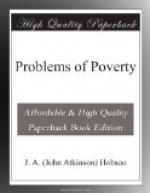The first readily suggests itself couched under the familiar phrase, Agricultural Depression. It is needless here to enlarge on this big and melancholy theme. It is evident that what is called the law of Diminishing Return to Labour in Agriculture, the fact that every additional labourer, upon a given surface, beyond a certain sufficient number, will be less and less profitably employed, while the indefinite expansion of manufacture will permit every additional hand to be utilized so as to increase the average product of each worker, would of itself suffice to explain why in a fairly thickly populated country like England, young labourers would find it to their interest to leave the land and seek manufacturing work in the cities. This would of itself explain why the country population might stand still while the city grew. When to this natural tendency we add the influence of the vast tracts of virgin, or cheaply cultivated soil, brought into active competition with English agriculture by the railways and steamships which link us with distant lands in America, Australia, and Asia, we have a fully adequate explanation of the main force of the tide in the movement of population. After a country has reached a certain stage in the development of its resources, the commercial population must grow more quickly than the agricultural, and the larger the outside area open to supply agricultural imports the faster the change thus brought about in the relation of city and rural population.
Sec. 4. Nature of the Decline of Rural Population.—It has been shown that the absolute reduction in the number of those living in rural districts is very small. If, however, we take the statistics of farmers and farm-labourers in these same districts we often find a very considerable decline. The real extent of the decline of agriculture is somewhat concealed by the habit of including in the agricultural population a good many people not engaged in work of agriculture. The number of retail shopkeepers, railway men and others concerned with the transport of goods, domestic servants, teachers, and others not directly occupied in the production of material wealth, has considerably increased of late years. So too, not every form of agriculture has declined. While farmers and labourers show a decrease, market-gardeners show a large increase, and there seem to be many more persons living in towns who cultivate a bit of land in the country as a subsidiary employment.
Taken as a whole the absolute fall off in the number of those working upon the soil is not large. The decline of small country industries is much more considerable. Here another law of industrial motion comes in, the rapid tendency of manufacture towards centralization in the towns, which we have discussed in the last chapter. Here we are concerned only with its effect in stamping out small rural industries. The growth of the railway has been the chief agent in the work. Wherever the railroad has penetrated




